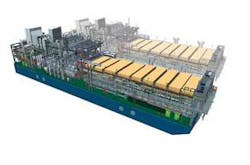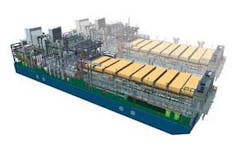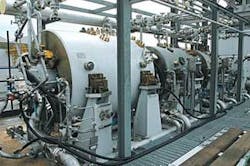Full load test addresses concerns over Kashagan H2S gas compression
Enhanced oil recovery (EOR) methodologies face increasingly extreme challenges when handling gas streams characterized by high levels of contamination, as is the case with the giant Kashagan oilfield development offshore Kazakhstan.
To mitigate the inherent risks as much as possible, the new engineering designs and technologies to be applied must be proven prior to field start-up. One example of how this is done is the full load test that GE Oil & Gas conducted successfully for this project on the highest pressure re-injection train ever built. The test was a critical part of operator Agip KCO’s risk abatement process for Kashagan.
At the core of the project’s EOR process, GE is supplying two ultra-high-pressure, barge-mounted, sour gas re-injection trains. The barge contains a full compression island that includes a 32-MW compression train capable of 820 bar delivery pressure, designed to withstand the 33% H2S found in the gas stream.
Each re-injection barge is 95 m long, 16 m wide and 25 m high. These dimensions have been limited by the need to navigate through Russian internal waterways. Furthermore, the configuration is also constrained by disassembly requirements dictated by lifting operations, weight distribution, safety, operability and maintainability. For all of these reasons, the layout of the topside equipment has been one of the toughest challenges within this already difficult project.
The barge weight is also a crucial factor in the risk abatement process. In the actual operating conditions, this can exceed 4,500 tons. For Kashagan, the need to limit the height to 16 m during navigation and the weight to 4,000 tons during lifting requires disassembly of part of the topside. In addition, the weight needs to be carefully distributed in order to make the barge seaworthy and to limit distortions during lifting and in the final operating configuration fixed to the supporting piles.
Safety considerations have also necessitated the allotment of adequate space for escape routes. At the same time, all heavy equipment had to be arranged within a limited space, making it necessary to work on multiple levels of the topsides. Furthermore, despite the heavy use of remote control operation, physical accessibility has been provided for all instrumentation as well as for manual operation of valves, vents, and drains.
The construction and maintenance of a 3D model was a key element in helping the team achieve an acceptable compromise for all these targets. 3D reviews were held at different stages of the project to ensure that the overall objectives of safety, operability and maintainability were under control. Material management - also aided by the 3D model - was particularly important because of the long delivery time and the cost associated with the heavy wall, low alloy steel piping components.
Testing requirements
GE’s Oil & Gas business has extensive experience in high-pressure re-injection. Its Nuovo Pignone testing facility, located in Massa, Italy, was the first to conduct full-power, full-pressure, and full-speed testing of discharge pressures of up to 11,800 psi (820 bar). The testing facilities were set up to replicate all the key features of the plant site conditions. The train used during testing consisted of an MS5002/D DLN gas turbine and gear box driving the BCL404/B + BCL304/C + BCL304/E centrifugal compressors.
The test loop for Kashagan was very carefully managed during its design, erection and certification. Using a continuous monitoring system, the gas loop was kept under pressure for the entire test duration. Furthermore, all controls were implemented for remote operation in order to replicate the on-site conditions where a very high degree of unmanned operation is required.
Since the toxic nature of the process gas is such an issue in this project, the sealing of all equipment was monitored and verified through dedicated procedures. In fact, a patented “zero leakage” monitoring system was developed to ensure detection of even ppm leakages at the compressor casing and inner casing interfaces. Finally, the equations of state used during the design stage for this unique process gas were validated by the test, thereby assuring compressor performance control and robustness of the dry gas seal design.
With the success of this full load test, GE Oil & Gas has demonstrated its ability to predict the compression train performance and to design full compression islands capable of handling these latest industry requirements. This test program allows our customers to confidently proceed with field development with the certainty that their main plant equipment will deliver the required performance, and that the plant design will perform as required under these most challenging environmental and process conditions.


